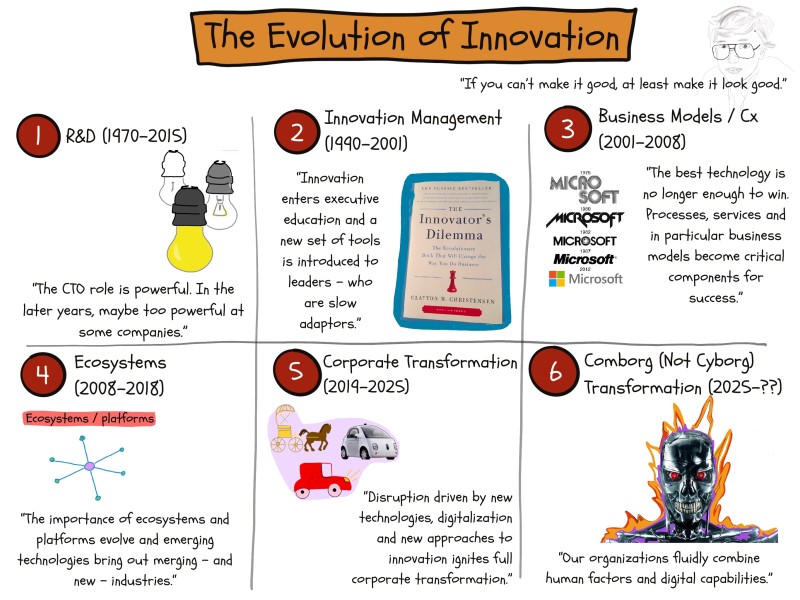
GUEST POST from Stefan Lindegaard
Half a decade ago, I laid out a perspective on the evolution of innovation. Now, I return to these reflections with a sentiment of both awe and unease as I observe the profound impacts of AI on innovation and business at large. The transformation unfolding before us presents a remarkable panorama of opportunities, yet it also carries with it the potential for disruption, hence the mixed feelings.
1. The Reign of R&D (1970-2015): There was a time when the Chief Technology Officer (CTO) held the reins. The focus was almost exclusively on Research and Development (R&D), with the power of the CTO often towering over the innovative impulses of the organization. Technology drove progress, but a tech-exclusive vision could sometimes be a hidden pitfall.
2. Era of Innovation Management (1990-2001): A shift towards understanding innovation as a strategic force began to emerge in the ’90s. The concept of managing innovation, previously only a flicker in the business landscape, began its journey towards being a guiding light. Pioneers like Christensen brought innovation into the educational mainstream, marking a paradigm shift in the mindsets of future business leaders.
3. Business Models & Customer Experience (2001-2008): The millennium ushered in an era where simply possessing superior technology wasn’t a winning card anymore. Process refinement, service quality, and most critically, innovative business models became the new mantra. Firms like Microsoft demonstrated this shift, evolving their strategies to stay competitive in this new game.
4. Ecosystems & Platforms (2008-2018): This phase saw the rise of ecosystems and platforms, representing a shift from isolated competition to interconnected collaboration. The lines that once defined industries began to blur. Companies from emerging markets, particularly China, became global players, and we saw industries morphing and intermingling. Case in point: was it still the automotive industry, or had the mobility industry arrived?
5. Corporate Transformation (2019-2025): With the onslaught of digital technologies, corporations faced the need to transform from within. Technological adoption wasn’t a mere surface-level change anymore; it demanded a thorough, comprehensive rethinking of strategies, structures, and processes. Anything less was simply insufficient to weather the storm of this digital revolution.
6. Comborg Transformation (2025-??): As we gaze into the future, the ‘Comborg’ era comes into view. This era sees organizations fusing human elements and digital capabilities into a harmonious whole. In this stage, the equilibrium between human creativity and AI-driven efficiency will be crucial, an exciting but challenging frontier to explore.
I believe that revisiting this timeline of innovation’s evolution highlights the remarkable journey we’ve undertaken. As we now figure out the role of AI in innovation and business, it’s an exciting but also challenging time. Even though it can be a bit scary, I believe we can create a successful future if we use AI in a responsible and thoughtful way.

Image Credit: Stefan Lindegaard, Unsplash
![]() Sign up here to get Human-Centered Change & Innovation Weekly delivered to your inbox every week.
Sign up here to get Human-Centered Change & Innovation Weekly delivered to your inbox every week.